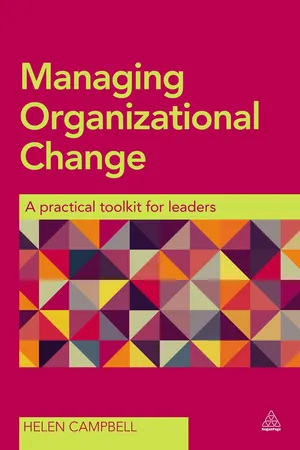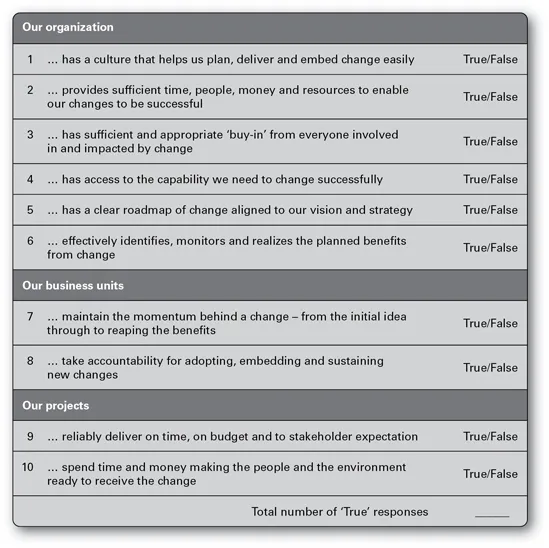![]()
01
It’s not working!
A change is successful when the people involved and impacted agree the reward was worth the risk and the value created was worth the investment.
Research from Accenture’s Paul Nunes and Tim Breene (2011) shows that only 7 per cent of companies which cease to grow ever manage to survive for the long term. We know from nature that just about everything needs to adapt to survive and for most organizations the aim is to do more than just survive. Commercial companies want to out-perform the competition, government and not-for-profit organizations want to provide the best services at the lowest cost. A critical area of competitive advantage nowadays is the ability of organizations to lead rather than follow changes in the market and this means having the ability to roll out the right changes quickly and reliably in a way that delivers a return on investment for the organization. Whether you are changing because you want to, or because you have to, change is difficult.
Successful organizations actively change to better fit with their external environments. They engage in self-betterment and risk-taking in response to intensifying competition. Change is accepted as the norm (Bahrami, 1992; Claver et al, 1998; Denison and Mishra, 1995; Smith, 1998).
We know the facts – the rate and complexity of change in and around our organizations is increasing. What most organizations haven’t yet managed to do is build the capability to respond reliably to those forces let alone stay ahead of them. We know project success rates are still disappointing and change failures continue to make the headlines. IBM’s 2012 CEO survey found that 72 per cent of leaders were focused on reacting more quickly to market needs. In 2010 the same survey found that three out of the CEOs’ top seven priorities related to change.1
It’s important to begin any improvement initiative with a good understanding of where you are starting. Take a look at the assessment in Figure 1.1. The questions are based on the components that together contribute to successful change. Be brutally honest in your judgement … if you can’t find convincing evidence that the statement is true you should mark it ‘false’.
Figure 1.1 Organizational change capability self-assessment
If you answered ‘True’ to all of the questions then you’re already getting it right. The reality is that the majority of organizations score between two and four ‘Trues’. No matter how your organization scored you will already be building an awareness of the diversity of components required for successful change.
It is possible our organizations used to be better at rolling out changes. There were fewer of them and so they were arguably subject to more planning and rigour. Perhaps our staff and customers had lower expectations or were more compliant. The change models of the mid-20th century talked about periods of unfreezing, transition and refreezing as if change was a one-off event that started, reached a tangible end and let everyone ‘refreeze’ into the new status quo.2 By contrast, most of our organizations today change so frequently we don’t really know what our ‘status quo’ is. We live in a constant state of flux making it hard to know where we are or which change to do next. Changes now need to be integrated into evolving organizations operating in a complex dynamic environment. Change just got harder.
Many of the costs of poor change are hidden – either accepted as a necessary evil or deliberately overlooked in an attempt to make us feel that we are doing a good job – but there are many studies which show project failure rates of around 70 per cent.3 Whilst this figure is shocking, it is the reality of what goes on behind this revelation that is more alarming when you see the time organizations spend fixing, redirecting or re-energizing those projects that didn’t deliver. There’s also the change-crippling damage done by the cynicism and inertia that builds as people develop a view that nothing will ever be delivered or that changes don’t deliver real business improvements. If either the change or the failure of it made the headlines there is considerable brand damage too.
It is no secret, if we choose to face it, that many organizations need to change but aren’t very good at it. Despite decades of improvements in governance and project management most organizations are a long way from where they need to be. They are still wasting taxpayer or shareholder money, putting their performance at risk and upsetting their staff and customers whenever they roll out so-called improvements.
Most leaders recognize when their change attempts are in jeopardy. The three most common signs they cite are a destructive tension between those delivering the changes and those on the receiving end; unacceptable disruption to customers, staff and/or business performance; and a belief that the change delivered a poor or unknown return on investment.
The project team and the business don’t get on
61 per cent of managers reported major conflicts between project and line organizations (Meskendahl et al, 2011).
‘We asked the business what they wanted and they couldn’t tell us.’ It is easy to see how tension can quickly build between the project team delivering the change and the business team receiving the change. The project team are trying to build tomorrow’s organization. They have been asked to do a job and can see ‘the business’ as getting in the way or not co-operating. They may believe they understand the business and should be able to make decisions in order to maintain progress and meet deadlines. When business consultation becomes necessary (as it inevitably does!) it is seen as a threat to the project timeline.
‘The project team have no idea how we run this business.’ Likewise we can see how the impacted business people can believe the project team do not have their best interests at heart. It can be overwhelming if the change feels like a steam train bearing down on startled staff and customers. The business is trying to run today’s organization; their KPIs and scarce resources are fully dedicated to meeting this quarter’s targets. A change that is some way off does not get much attention.
Fundamentally these two groups are driven by conflicting agendas and organizations must find ways for them to work together in harmony with common goals if the long-term benefits are to be achieved. If not addressed your project and business staff will remain demoralized; your organization will continue to produce changes that are unlikely to be accepted by those receiving them and you are unlikely to deliver any benefits.
Poor change disrupts the business
Eight out of nine teams experience a drop in productivity during times of change (Parry and Kirsch, 2011).
The second evidence commonly cited by leaders is the high level of disruption their changes are causing to customers, staff and their overall business performance. It seems obvious that changes that impact customers need special care yet many organizations still perform a cursory impact analysis and provide minimal support. Internal changes that have a negative impact on customer-fronting staff can also increase the risk of losing customers. This might be at a local level caused by a poor customer experience or across the board by creating damage to your brand.
Whether driven by curiosity or anxiety it is not unusual for staff to be distracted or disillusioned during times of change. If the change is poorly managed or the potential negative impact is significant, those who can do so easily (usually your top performers) will leave the organization. Others will reduce their productivity and make future attempts to change a lot harder. It is easy to see how business performance takes a dip during times of change. Revenues can fall and staff productivity has the potential to plummet for a long period before, during and after a poorly managed change. Sickness and staff turnover go up and employee satisfaction goes down.
The consequences of disruptive change are clear. Low productivity, staff and customer turnover are hard and expensive problems to fix. Poor business performance, combined with poor change delivery may lead your investors to lose faith and be wary about future investments. Change gets harder for organizations that have mismanaged it in the past. They are constantly faced with the cynicism, anxiety and fatigue they left behind after the last change.
Poor return on investment
The three types of return on investment necessary to sustain successful change: financial, emotional and organizational
A group of more than 1,500 executives were asked by consulting firm McKinsey (2006) whether a recent change to their organization had resulted in improved performance; just over a third were able to say yes, a third said no or ‘not sure’ with the remainder saying their change initiatives were ‘somewhat’ successful. If you are unable to confidently answer yes to this simple question, then the change has failed. Even those who answered ‘somewhat’ wouldn’t be providing their investors with much comfort as it is likely that these initiatives cost considerable time, money and energy and a ‘somewhat’ successful improvement seems inadequate.
Organizations often fail to realize the three types of return on investment necessary to sustain successful change; financial, emotional and organizational return. Poor financial return on investment means we don’t achieve, or we don’t know if we achieved, the value we needed in return for the money we invested. Organizations that find change difficult often do not have the skills or experience to set a realistic return on investment (ROI) and they often have no process to monitor and update this as the change progresses. We would never invest our own money the way we seem to be happy to invest our organization’s money. If your financial planner offered you a product with little information about the return on that investment, you’d never buy it. Yet every day our organizations invest millions in changes for which they may never see a return.
Poor emotional return on investment means the people involved and impacted don’t get the satisfaction they need in return for all the effort they put in. This leads to apathy and undermines the organization’s future ...

